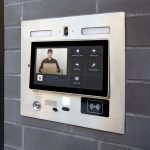
CHOOSE THE BEST ACCESS CONTROL SYSTEM FOR YOUR BUSINESS

CHOOSE THE BEST ACCESS CONTROL SYSTEM FOR YOUR BUSINESS
We supply, install, repair, and maintain Access Control systems. Different business premises have different kinds of needs, but Access Control is the core for all security plans for businesses. There are areas on the premises that have free access and some sensitive areas where only certain authorized employees can enter. The different types of Access Control are meant to manage the security needs specific to your business by minimizing the risks of security breach.
Although the core purpose of all Access Control Systems is to protect your business, not all of them work in the same way. There are different kinds of access control

DISCRETIONARY ACCESS CONTROL SYSTEMS (DACS)
The discretionary Access control Systems allow the business owners to decide who they want to grant access to enter their premises, or specific locations on the premises. Each point of access control is associated with a list of authorized users who are allowed to go beyond the point. With every swipe of card, scan of fingerprint or use of fob key, the data is collected and matched with the already existing allowances. The access is granted or denied based on that.
DACS are considered to be one of the most flexible forms of access control and hence, one of the most widely used. Because of their flexibility and ability to be modified, they are not ideal for overly sensitive areas. Access can be granted at the discretion of the person under control and is hence only ideal for business that allow ease of use of the premises.

MANDATORY ACCESS CONTROL SYSTEMS (MACS)
Mandatory Access Control Systems are the most secure, only recommended for organizations that need to maintain high levels of confidentiality, such as military-based organizations. The MAC Systems classify all the users and assign relevant labels to them. Instead of having an access list at the point of access, each user requires individual permissions to be set up in the system.
These are the strictest and most inflexible of all systems. In order to change the permissions for the user, the system administrator would need to reprogram the specific user’s access entirely. Changing just the access list at the entry point will not suffice in this case.

ROLE-BASED ACCESS CONTROL SYSTEMS
This type of access control system is quickly gaining popularity due to their quick adaptability and high levels of security. Under the Role-Based Access Control Systems, access is granted to people with certain job titles. For instance, if a business has 3 salespersons, 1 Brand Manager and 2 Account Managers, permissions would be granted based on their positions and not on an individual basis. Only 3 levels of allowances would need to be created in this case. Any new person assuming these titles, be it a new hire or a promoted person, would have the same access.
For moderate levels of control, the RBAC systems are the most preferred because of their uncomplex nature and flexibility.
RULE-BASED ACCESS CONTROL SYSTEMS

The Rule-Based Access Control Systems, although not as common, are sometimes confused with their Role-Based counterparts. These are meant to be used as an add on to the other types of access control systems, relevant in situations where a common rule is applicable for every individual in the organization, regardless of their job roles.
For instance, if a business premise is scheduled to be closed from 6:00 PM – 7:00 AM, there is no need for any individual to have access to the premises between this period.
Installing access control systems is important for businesses, however, having the right one is even more important. Our experts are committed to providing the best services and precise knowledge in the field of access control, so that our clients can choose and deploy what’s best for them.

DISCRETIONARY ACCESS CONTROL SYSTEMS (DACS)

CHOOSE THE BEST ACCESS CONTROL SYSTEM FOR YOUR BUSINESS
We supply, install, repair, and maintain Access Control systems. Different business premises have different kinds of needs, but Access Control is the core for all security plans for businesses. There are areas on the premises that have free access and some sensitive areas where only certain authorized employees can enter. The different types of Access Control are meant to manage the security needs specific to your business by minimizing the risks of security breach.
Although the core purpose of all Access Control Systems is to protect your business, not all of them work in the same way. There are different kinds of access control

DISCRETIONARY ACCESS CONTROL SYSTEMS (DACS)
The discretionary Access control Systems allow the business owners to decide who they want to grant access to enter their premises, or specific locations on the premises. Each point of access control is associated with a list of authorized users who are allowed to go beyond the point. With every swipe of card, scan of fingerprint or use of fob key, the data is collected and matched with the already existing allowances. The access is granted or denied based on that.
DACS are considered to be one of the most flexible forms of access control and hence, one of the most widely used. Because of their flexibility and ability to be modified, they are not ideal for overly sensitive areas. Access can be granted at the discretion of the person under control and is hence only ideal for business that allow ease of use of the premises.

MANDATORY ACCESS CONTROL SYSTEMS (MACS)
Mandatory Access Control Systems are the most secure, only recommended for organizations that need to maintain high levels of confidentiality, such as military-based organizations. The MAC Systems classify all the users and assign relevant labels to them. Instead of having an access list at the point of access, each user requires individual permissions to be set up in the system.
These are the strictest and most inflexible of all systems. In order to change the permissions for the user, the system administrator would need to reprogram the specific user’s access entirely. Changing just the access list at the entry point will not suffice in this case.

ROLE-BASED ACCESS CONTROL SYSTEMS
This type of access control system is quickly gaining popularity due to their quick adaptability and high levels of security. Under the Role-Based Access Control Systems, access is granted to people with certain job titles. For instance, if a business has 3 salespersons, 1 Brand Manager and 2 Account Managers, permissions would be granted based on their positions and not on an individual basis. Only 3 levels of allowances would need to be created in this case. Any new person assuming these titles, be it a new hire or a promoted person, would have the same access.
For moderate levels of control, the RBAC systems are the most preferred because of their uncomplex nature and flexibility.
RULE-BASED ACCESS CONTROL SYSTEMS

The Rule-Based Access Control Systems, although not as common, are sometimes confused with their Role-Based counterparts. These are meant to be used as an add on to the other types of access control systems, relevant in situations where a common rule is applicable for every individual in the organization, regardless of their job roles.
For instance, if a business premise is scheduled to be closed from 6:00 PM – 7:00 AM, there is no need for any individual to have access to the premises between this period.
Installing access control systems is important for businesses, however, having the right one is even more important. Our experts are committed to providing the best services and precise knowledge in the field of access control, so that our clients can choose and deploy what’s best for them.

MANDATORY ACCESS CONTROL SYSTEMS (MACS)

CHOOSE THE BEST ACCESS CONTROL SYSTEM FOR YOUR BUSINESS
We supply, install, repair, and maintain Access Control systems. Different business premises have different kinds of needs, but Access Control is the core for all security plans for businesses. There are areas on the premises that have free access and some sensitive areas where only certain authorized employees can enter. The different types of Access Control are meant to manage the security needs specific to your business by minimizing the risks of security breach.
Although the core purpose of all Access Control Systems is to protect your business, not all of them work in the same way. There are different kinds of access control

DISCRETIONARY ACCESS CONTROL SYSTEMS (DACS)
The discretionary Access control Systems allow the business owners to decide who they want to grant access to enter their premises, or specific locations on the premises. Each point of access control is associated with a list of authorized users who are allowed to go beyond the point. With every swipe of card, scan of fingerprint or use of fob key, the data is collected and matched with the already existing allowances. The access is granted or denied based on that.
DACS are considered to be one of the most flexible forms of access control and hence, one of the most widely used. Because of their flexibility and ability to be modified, they are not ideal for overly sensitive areas. Access can be granted at the discretion of the person under control and is hence only ideal for business that allow ease of use of the premises.

MANDATORY ACCESS CONTROL SYSTEMS (MACS)
Mandatory Access Control Systems are the most secure, only recommended for organizations that need to maintain high levels of confidentiality, such as military-based organizations. The MAC Systems classify all the users and assign relevant labels to them. Instead of having an access list at the point of access, each user requires individual permissions to be set up in the system.
These are the strictest and most inflexible of all systems. In order to change the permissions for the user, the system administrator would need to reprogram the specific user’s access entirely. Changing just the access list at the entry point will not suffice in this case.

ROLE-BASED ACCESS CONTROL SYSTEMS
This type of access control system is quickly gaining popularity due to their quick adaptability and high levels of security. Under the Role-Based Access Control Systems, access is granted to people with certain job titles. For instance, if a business has 3 salespersons, 1 Brand Manager and 2 Account Managers, permissions would be granted based on their positions and not on an individual basis. Only 3 levels of allowances would need to be created in this case. Any new person assuming these titles, be it a new hire or a promoted person, would have the same access.
For moderate levels of control, the RBAC systems are the most preferred because of their uncomplex nature and flexibility.
RULE-BASED ACCESS CONTROL SYSTEMS

The Rule-Based Access Control Systems, although not as common, are sometimes confused with their Role-Based counterparts. These are meant to be used as an add on to the other types of access control systems, relevant in situations where a common rule is applicable for every individual in the organization, regardless of their job roles.
For instance, if a business premise is scheduled to be closed from 6:00 PM – 7:00 AM, there is no need for any individual to have access to the premises between this period.
Installing access control systems is important for businesses, however, having the right one is even more important. Our experts are committed to providing the best services and precise knowledge in the field of access control, so that our clients can choose and deploy what’s best for them.

ROLE-BASED ACCESS CONTROL SYSTEMS

CHOOSE THE BEST ACCESS CONTROL SYSTEM FOR YOUR BUSINESS
We supply, install, repair, and maintain Access Control systems. Different business premises have different kinds of needs, but Access Control is the core for all security plans for businesses. There are areas on the premises that have free access and some sensitive areas where only certain authorized employees can enter. The different types of Access Control are meant to manage the security needs specific to your business by minimizing the risks of security breach.
Although the core purpose of all Access Control Systems is to protect your business, not all of them work in the same way. There are different kinds of access control

DISCRETIONARY ACCESS CONTROL SYSTEMS (DACS)
The discretionary Access control Systems allow the business owners to decide who they want to grant access to enter their premises, or specific locations on the premises. Each point of access control is associated with a list of authorized users who are allowed to go beyond the point. With every swipe of card, scan of fingerprint or use of fob key, the data is collected and matched with the already existing allowances. The access is granted or denied based on that.
DACS are considered to be one of the most flexible forms of access control and hence, one of the most widely used. Because of their flexibility and ability to be modified, they are not ideal for overly sensitive areas. Access can be granted at the discretion of the person under control and is hence only ideal for business that allow ease of use of the premises.

MANDATORY ACCESS CONTROL SYSTEMS (MACS)
Mandatory Access Control Systems are the most secure, only recommended for organizations that need to maintain high levels of confidentiality, such as military-based organizations. The MAC Systems classify all the users and assign relevant labels to them. Instead of having an access list at the point of access, each user requires individual permissions to be set up in the system.
These are the strictest and most inflexible of all systems. In order to change the permissions for the user, the system administrator would need to reprogram the specific user’s access entirely. Changing just the access list at the entry point will not suffice in this case.

ROLE-BASED ACCESS CONTROL SYSTEMS
This type of access control system is quickly gaining popularity due to their quick adaptability and high levels of security. Under the Role-Based Access Control Systems, access is granted to people with certain job titles. For instance, if a business has 3 salespersons, 1 Brand Manager and 2 Account Managers, permissions would be granted based on their positions and not on an individual basis. Only 3 levels of allowances would need to be created in this case. Any new person assuming these titles, be it a new hire or a promoted person, would have the same access.
For moderate levels of control, the RBAC systems are the most preferred because of their uncomplex nature and flexibility.
RULE-BASED ACCESS CONTROL SYSTEMS

The Rule-Based Access Control Systems, although not as common, are sometimes confused with their Role-Based counterparts. These are meant to be used as an add on to the other types of access control systems, relevant in situations where a common rule is applicable for every individual in the organization, regardless of their job roles.
For instance, if a business premise is scheduled to be closed from 6:00 PM – 7:00 AM, there is no need for any individual to have access to the premises between this period.
Installing access control systems is important for businesses, however, having the right one is even more important. Our experts are committed to providing the best services and precise knowledge in the field of access control, so that our clients can choose and deploy what’s best for them.
RULE-BASED ACCESS CONTROL SYSTEMS


CHOOSE THE BEST ACCESS CONTROL SYSTEM FOR YOUR BUSINESS
We supply, install, repair, and maintain Access Control systems. Different business premises have different kinds of needs, but Access Control is the core for all security plans for businesses. There are areas on the premises that have free access and some sensitive areas where only certain authorized employees can enter. The different types of Access Control are meant to manage the security needs specific to your business by minimizing the risks of security breach.
Although the core purpose of all Access Control Systems is to protect your business, not all of them work in the same way. There are different kinds of access control

DISCRETIONARY ACCESS CONTROL SYSTEMS (DACS)
The discretionary Access control Systems allow the business owners to decide who they want to grant access to enter their premises, or specific locations on the premises. Each point of access control is associated with a list of authorized users who are allowed to go beyond the point. With every swipe of card, scan of fingerprint or use of fob key, the data is collected and matched with the already existing allowances. The access is granted or denied based on that.
DACS are considered to be one of the most flexible forms of access control and hence, one of the most widely used. Because of their flexibility and ability to be modified, they are not ideal for overly sensitive areas. Access can be granted at the discretion of the person under control and is hence only ideal for business that allow ease of use of the premises.

MANDATORY ACCESS CONTROL SYSTEMS (MACS)
Mandatory Access Control Systems are the most secure, only recommended for organizations that need to maintain high levels of confidentiality, such as military-based organizations. The MAC Systems classify all the users and assign relevant labels to them. Instead of having an access list at the point of access, each user requires individual permissions to be set up in the system.
These are the strictest and most inflexible of all systems. In order to change the permissions for the user, the system administrator would need to reprogram the specific user’s access entirely. Changing just the access list at the entry point will not suffice in this case.

ROLE-BASED ACCESS CONTROL SYSTEMS
This type of access control system is quickly gaining popularity due to their quick adaptability and high levels of security. Under the Role-Based Access Control Systems, access is granted to people with certain job titles. For instance, if a business has 3 salespersons, 1 Brand Manager and 2 Account Managers, permissions would be granted based on their positions and not on an individual basis. Only 3 levels of allowances would need to be created in this case. Any new person assuming these titles, be it a new hire or a promoted person, would have the same access.
For moderate levels of control, the RBAC systems are the most preferred because of their uncomplex nature and flexibility.
RULE-BASED ACCESS CONTROL SYSTEMS

The Rule-Based Access Control Systems, although not as common, are sometimes confused with their Role-Based counterparts. These are meant to be used as an add on to the other types of access control systems, relevant in situations where a common rule is applicable for every individual in the organization, regardless of their job roles.
For instance, if a business premise is scheduled to be closed from 6:00 PM – 7:00 AM, there is no need for any individual to have access to the premises between this period.
Installing access control systems is important for businesses, however, having the right one is even more important. Our experts are committed to providing the best services and precise knowledge in the field of access control, so that our clients can choose and deploy what’s best for them.


























